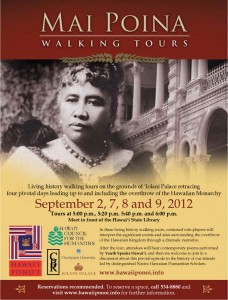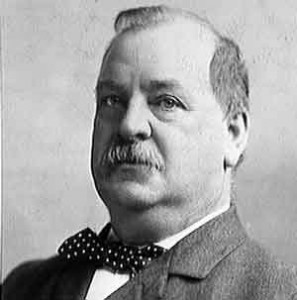September 2 is the birthday of Hawai’i’s last reigning monarch, Lili’uokalani. Born in a grass house in 1838 and adopted by Hawai’i’s ruling dynasty, the infant girl who would become Hawai’i’s last queen began her tumultuous life 174 years ago at the base of an dormant volcano in Honolulu.
For the past several years, historians, Hawaiian cultural practitioners, and others who keep Lili’uokalaini’s memory alive, have gathered at the grounds of ‘Iolani Palace on her birthday to lead walking historical walking tours in an event called Mai Poina (Don’t Forget.) The tour on her birthday sold out but there are still a few spots left this coming weekend, September 7-9.
This year’s Mai Poina is set to be a very unusual one. According to a story in the Honolulu Star-Advertiser, President Grover Cleveland’s grandson, George Cleveland, visited Hawaii this past weekend to celebrate Lili‘uokalani’s birthday. As part of that trip, he planned to take part in the Mai Poina re-enactment of the overthrow on the palace grounds.
Grover Cleveland, who was the newly elected Democratic president at the time of the overthrow, had doubts about what had happened over those four days in 1893 in the far-away independent kingdom of Hawai’i.
He hastily withdrew the Hawaiian annexation treaty, which his successor, Republican President Harrison, had hoped to push through before leaving office and appointed a special commissioner to investigate the matter that a New York Times headline decried as the “Political Crime of the Century.”
But partisan politics and heavy lobbying on the part of pro-annexation forces bogged down the question of restoring Liliuokalani to the throne. Not long after Cleveland’s successor Republican William McKinley took office, the Spanish-American war broke out – making Hawaii suddenly enormously valuable to the war effort as a vital refueling station between North America and Asia. Hawaii was quickly annexed by a joint resolution of Congress — not a vote — in 1898.
Upon hearing that news, Cleveland, who had retired to Princeton, New Jersey, spoke eloquently for those who had opposed annexation. “Hawaii is ours….as I contemplate the means used to complete the outrage, I am ashamed of the whole affair.”
With those words, Cleveland came to be revered by Hawaiians, some of whom continue to mourn the loss of their nation to this day. Indeed, to this day, Cleveland’s gravestone in Princeton is festooned with shell and flower lei in honor of the stance he took. My friend and colleague Silvia Ascarelli, who I know from our days together in the London bureau of the Wall Street Journal, took this photo and several others and sent them to me.

President Grover Cleveland’s headstone in Princeton, New Jersey, festooned with lei, courtesy of Silvia Ascarelli
The family tradition, it seems, is continuing. The Star-Advertiser reports that reports that George Cleveland has been working closely with Hawai‘i’s Pacific Justice & Reconciliation Center’s Cleveland-Lili‘uokalani Education Project. According to the Associated Press, which distributed the Star-Advertiser’s story, “(George Cleveland) says he’s occasionally the target of criticism for his partnership with the center but he believes there is some kind reparation due for the overthrow.”
I wish I could attend today’s re-enactment, but I was lucky enough to be in Honolulu during one of these gatherings two years ago. The walking tour was fascinating, but best of all was the opportunity to engage with University of Hawaii professors as well as a staffer from the Mission Houses Museum and others on a moment in history that continues to puzzle, anger, and grip so many people.
Mai Poina is co-sponsored by the Hawai‘i Council for the Humanities and the University of Hawai‘i’s Center for Biographical Research. It covers the four days in January 1893, leading up to the overthrow of the sovereign kingdom of Hawai‘i. By moving from station to station on the palace grounds, the tour covers many of the places where the overthrow occurred.
On the year I took the tour, the Center for Biographical Research’s director Craig Howes, dressed in period costume, playing the role of a Greek businessman commenting on the tense political environment. His scene took place at King Kalākaua’s Coronation Pavilion on the palace grounds. One of my favorite memories of that evening was of Craig delivering his lines at dusk on the steps of the pavilion, It turns out he’s an amateur actor in his spare time, and was very good in his role!





 Judith Fernandez says
Judith Fernandez says
September 3, 2012 at 3:01 pmThank you for helping to set the record straight. A few days ago, a very conservative acquaintance actually called us “traitors!” because we explained the error in Dinesh’s movie which implies Obama is a radical lefty because he states that America’s action deposing the Queen was a colonialist action. When I pointed out the actual facts, (and that Punahou was not a hotbed of radical leftist thinking which is also implied in the movie), the person became enraged and blurted out those words. It is scary to know that people are so brainwashed today that they can respond to factual discussions with nothing but emotional attacks.
Your book/etc. are invaluable since you aren’t Hawaiian, a colonialist, etc, and even write for the Wall Street Journal!. Aloha and Mahalo
 Diane Blue says
Diane Blue says
September 4, 2012 at 1:40 amI’m currently reading “Lost Kingdom”, and believe the US did unlawfully take over Hawai’i.
 Alghero Sardinia says
Alghero Sardinia says
May 7, 2015 at 2:38 pmI feel this is among the so much significant info for me.
And i’m happy studying your article. But should remark on some basic
issues, The website taste is great, the articles is in point
of fact nice : D. Good process, cheers
 stephen voss says
stephen voss says
June 25, 2015 at 4:02 pmThat tombstone is not grover clevelands, its his 12 year old daughters tombstone.
 Julia Flynn Siler says
Julia Flynn Siler says
September 25, 2015 at 12:22 pmThanks for noting that, Stephen. A college friend of mine from Princeton sent me that photo. I appreciate the correction.